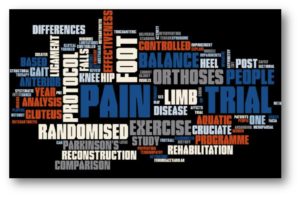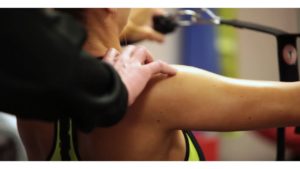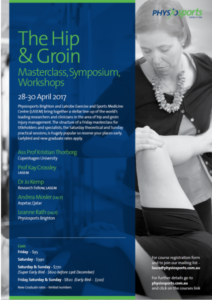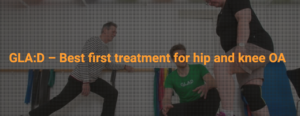The staff at La Trobe Sports & Exercise Medicine Research Centre (La Trobe SEMRC) have welcomed in the New Year with 19 new publications in January. These were in the areas of hip & knee osteoarthritis, Parkinson’s disease, chronic obstructive pulmonary disease (COPD), anterior cruciate ligament reconstruction, patellofemoral knee pain and heel pain. The diversity of these publications reflects the breadth of research interests and expertise within the centre. (1-19)
 The interventions within these papers included;
The interventions within these papers included;
- Foot orthoses
- Aquatic therapy
- Pre-operative & home based exercise programs
- Cortisone injections
- Cutting edge technology to assess standing balance
- Muscle function & biomechanics
In no specific order, our top four papers include:
- The treatment of multidirectional instability of the shoulder with a rehabilitation programme: Part 2. Shoulder and Elbow [Watson et al., 2017; La Trobe staff members and/or affiliates Dr Tania Pizzari, Dr Lyn Watson, Sarah Warby, Ross Lenssen](17)
 This paper is the second in a two-part series which describes stages 3-6 of an outcome based rehabilitation program for multidirectional shoulder instability and is absolute gold for those that treat shoulder pain patients. The rehabilitation program, named the Watson program, consists of six stages focusing on controlled movements with an emphasis on scapular and humeral head positioning. This is a key paper for clinicians working with musculoskeletal shoulder pain and a great clinical and teaching resource. The flexibility of the program accounts for the knowledge and skill of the clinician and allows patient-centered goals to be set.
This paper is the second in a two-part series which describes stages 3-6 of an outcome based rehabilitation program for multidirectional shoulder instability and is absolute gold for those that treat shoulder pain patients. The rehabilitation program, named the Watson program, consists of six stages focusing on controlled movements with an emphasis on scapular and humeral head positioning. This is a key paper for clinicians working with musculoskeletal shoulder pain and a great clinical and teaching resource. The flexibility of the program accounts for the knowledge and skill of the clinician and allows patient-centered goals to be set.
The effectiveness of the Watson program is being tested in a separate randomized controlled trial (Australian New Zealand Clinical Trials Registry #ACTRN12613001240730). The problem with many published studies from a clinical perspective is there is often insufficient information provided on the specific parameters (e.g. dosage, timing, positioning and progression) to enable clinicians to replicate the interventions in clinical practice. There are many reasons for this, including word limits on papers and lack of clinician input in the reporting of studies. This great paper provides a solution.
- Pain, not structural impairments, may explain activity limitations in people with gluteal tendinopathy or hip osteoarthritis: A cross sectional study. Gait and Posture [Fearon et al. La Trobe staff member Professor Jill Cook](5)
 The problem with biomechanical studies is that although the measurements and findings can be very accurate, they are also difficult to replicate in the clinical environment. This paper used clinical measures of walking, balance and hip strength (involving a measuring tape, stop watch
The problem with biomechanical studies is that although the measurements and findings can be very accurate, they are also difficult to replicate in the clinical environment. This paper used clinical measures of walking, balance and hip strength (involving a measuring tape, stop watch
and dynamometer) to measure differences in these variables between people with greater trochanThe study found that those with GT and hip OA walked more slowly oteric pain syndrome (GT), hip osteoarthritis (OA) and an asymptomatic comparison group. A reliability analysis was also included.
The study found that those with GT and hip OA walked more slowly on the 10 metre walk, timed up & go tests with a lower cadence (steps per minute) and had a shorter duration of single leg stance on their affected leg. People with GT & hip OA demonstrated weaker hip abduction and those with hip OA demonstrated weaker hip adduction compared to the GT and asymptomatic groups.
This was a cross sectional study (point in time) so the causes of these impairments are unclear. However, the authors suggest that the pain associated with GT and hip OA may play a greater role in functional limitations . From a clinical perspective, they point out that the self-selected walking speeds of the participants who had pain were relatively slow and some patients may have trouble safely crossing a road (minimum of 1.22 metres per second is required to safely cross a controlled intersection).
- Effectiveness of Aquatic Exercise in Improving Lower Limb Strength in Musculoskeletal Conditions: A Systematic Review and Meta-Analysis. Archives of Physical Medicine and Rehabilitation [Heywood et al. La Trobe staff member Dr Jodie McClelland](10)
Patients with joint pain are often referred to aquatic exercise (hydrotherapy) for muscle strengthening & general conditioning. There may be many physiological, psychological & social benefits of aquatic exercise in the early stages of rehabilitation, but is aquatic exercise effective for improving muscle strength? There answer is probably ‘no’!!!
 This systematic review & meta-analysis investigated the effectiveness of aquatic exercise for improving lower limb muscle strength in adults with musculoskeletal conditions. These conditions included hip & knee osteoarthritis, rheumatoid arthritis, knee replacement and reconstruction surgery and fibromyalgia syndrome. The review ultimately included 15 randomised controlled trials, all of which compared aquatic exercise with a resistance component to no intervention or land-based exercise.
This systematic review & meta-analysis investigated the effectiveness of aquatic exercise for improving lower limb muscle strength in adults with musculoskeletal conditions. These conditions included hip & knee osteoarthritis, rheumatoid arthritis, knee replacement and reconstruction surgery and fibromyalgia syndrome. The review ultimately included 15 randomised controlled trials, all of which compared aquatic exercise with a resistance component to no intervention or land-based exercise.
All of the included studies involved either two or three aquatic exercise sessions per week & ranged in duration from 6 to 52 weeks. The land-based exercises were primarily hip abduction & extension and/or knee flexion and various sub-maximal intensities, whereas the description of aquatic exercises within the studies was less specific. Clinicians who use aquatic exercise for musculoskeletal conditions will find the analysis of the parameters of the aquatic exercise programs quite useful (e.g. dosage, progression & positions).
The most important finding of the paper was that there was no difference between aquatic exercise and no exercise in improving hip abductor, knee flexor or knee extensor strength, or lower limb endurance – although these findings are based on low quality evidence. The authors point out the need for future studies to better quantify the resistance used in aquatic exercise, better document the resistance training principles that the programs are based on and determine the types of patients who may benefit most from aquatic exercise.
- Home-based rehabilitation for COPD using minimal resources: a randomised, controlled equivalence trial. [Holland et al. 2017. La Trobe staff members and or affiliates Dr Anne Holland, Annemarie Lee, Angela Burge, Dr Narelle Cox, Caroline Nicolson, Aroub Lahham, Rebecca Gillies](11)
Chronic obstructive pulmonary disease (COPD) is a category of lung disease which includes chronic bronchitis and emphysema. People with COPD typically have a lower health-related quality of life (HRQoL) and exercise tolerance than people of the same age without COPD, but can improve their HRQoL and exercise tolerance by participating in pulmonary rehabilitation programs. These programs are usually run in hospitals and rehabilitation centres and although they are effective, the cost and time associated with attending these sessions adds considerable burden to patients.
![]() This study compared a home-based pulmonary rehabilitation program to a traditional centre-based program and involved 166 participants with moderate to severe COPD and low levels of baseline physical activity. The home-based program involved only one home visit and seven once-weekly phone calls from a physiotherapist. This was compared to weekly supervised exercise sessions for the traditional program. The study design was a randomised controlled equivalence trial, which places emphasis on clinical significance (i.e. how important findings are to clinical practice) of the findings, not just statistical significance.
This study compared a home-based pulmonary rehabilitation program to a traditional centre-based program and involved 166 participants with moderate to severe COPD and low levels of baseline physical activity. The home-based program involved only one home visit and seven once-weekly phone calls from a physiotherapist. This was compared to weekly supervised exercise sessions for the traditional program. The study design was a randomised controlled equivalence trial, which places emphasis on clinical significance (i.e. how important findings are to clinical practice) of the findings, not just statistical significance.
Both the home-based and centre-based pulmonary rehabilitation programs resulted in short term improvements in HRQoL and exercise tolerance, but that improvements returned to baseline levels for both programs by 12 months. The study is important because it showed that a home-based program can give patients equivalent short term results as a centre-based program, and this may be useful for patients who cannot engage in traditional pulmonary rehabilitation programs. The study will inform further longer-term research in this area.
Stay tuned for more exciting research updates from La Trobe SEMRC
Check out our upcoming events
 |
 |
References
- Ackerman IN, Kemp JL, Crossley KM, Culvenor AG, Hinman RS. Hip and Knee Osteoarthritis Affects Younger People, Too. journal of orthopaedic & sports physical therapy. 2017;47(2):67-79.
- Bonanno DR, Landorf KB, Munteanu SE, Murley GS, Menz HB. Effectiveness of foot orthoses and shock-absorbing insoles for the prevention of injury: a systematic review and meta-analysis. British journal of sports medicine. 2017;51(2):86-96.
- Clark RA, Bell SW, Feller JA, Whitehead TS, Webster KE. Standing balance and inter-limb balance asymmetry at one year post primary anterior cruciate ligament reconstruction: Sex differences in a cohort study of 414 patients. Gait & Posture. 2017;52:318-24.
- Edwards S, Brooke HC, Cook JL. Distinct cut task strategy in Australian football players with a history of groin pain. Physical Therapy in Sport. 2017;23:58-66.
- Fearon A, Neeman T, Smith P, Scarvell J, Cook J. Pain, not structural impairments may explain activity limitations in people with gluteal tendinopathy or hip osteoarthritis: A cross sectional study. Gait & Posture. 2017;52:237-43.
- Ganderton C, Pizzari T, Harle T, Cook J, Semciw A. A comparison of gluteus medius, gluteus minimus and tensor facia latae muscle activation during gait in post-menopausal women with and without greater trochanteric pain syndrome. Journal of Electromyography and Kinesiology. 2017.
- Guenther JR, Cochrane CK, Crossley KM, Gilbart MK, Hunt MA. A Pre-Operative Exercise Intervention Can Be Safely Delivered to People with Femoroacetabular Impingement and Improve Clinical and Biomechanical Outcomes. Physiotherapy Canada. 2017:1-8.
- Hart HF, Crossley KM, Collins NJ, Ackland DC. Bracing of the Reconstructed and Osteoarthritic Knee during High Dynamic Load Tasks. Med Sci Sports Exerc. 2017.
- Hatton AL, Crossley KM, Clark RA, Whitehead TS, Morris HG, Culvenor AG. Between-leg differences in challenging single-limb balance performance one year following anterior cruciate ligament reconstruction. Gait & Posture. 2017;52:22-5.
- Heywood S, McClelland J, Mentiplay B, Geigle P, Rahmann A, Clark R. Effectiveness of Aquatic Exercise in Improving Lower Limb Strength in Musculoskeletal Conditions: A Systematic Review and Meta-Analysis. Archives of Physical Medicine and Rehabilitation. 2017;98(1):173-86.
- Holland AE, Mahal A, Hill CJ, Lee AL, Burge AT, Cox NS, et al. Home-based rehabilitation for COPD using minimal resources: a randomised, controlled equivalence trial. Thorax. 2017;72(1):57-65.
- McDonald VM, Wood LG, Holland AE, Gibson PG. Obesity in COPD: to treat or not to treat? : Taylor & Francis; 2017.
- McPherson L, Long M, Nicholson M, Cameron N, Atkins P, Morris ME. Secrecy surrounding the physical abuse of child athletes in Australia. Australian Social Work. 2017;70(1):42-53.
- Perrott MA, Pizzari T, Cook J, McClelland JA. Comparison of lower limb and trunk kinematics between markerless and marker-based motion capture systems. Gait & Posture. 2017;52:57-61.
- Ruehland WR, Rochford PD, Pierce RJ, Webster KE, Trinder JA, Jordan AS, et al. Sensory detection of threshold intensity resistive loads in severe obstructive sleep apnoea. Respiratory Physiology & Neurobiology. 2017;236:29-41.
- Volpe D, Pavan D, Morris M, Guiotto A, Iansek R, Fortuna S, et al. Underwater gait analysis in Parkinson’s disease. Gait & Posture. 2017;52:87-94.
- Watson L, Warby S, Balster S, Lenssen R, Pizzari T. The treatment of multidirectional instability of the shoulder with a rehabilitation programme: Part 2. Shoulder & Elbow. 2017;9(1):46-53.
- Webster KE, Feller JA, Whitehead TS. Return to Sport following ACL Reconstruction: The Australian Experience. Rotatory Knee Instability: Springer; 2017. p. 413-26.
- Whiteside M, Bould E, Tsey K, Venville A, Cadet-James Y, Morris ME. Promoting Twenty-first-century Student Competencies: A Wellbeing Approach. Australian Social Work. 2017:1-13.

